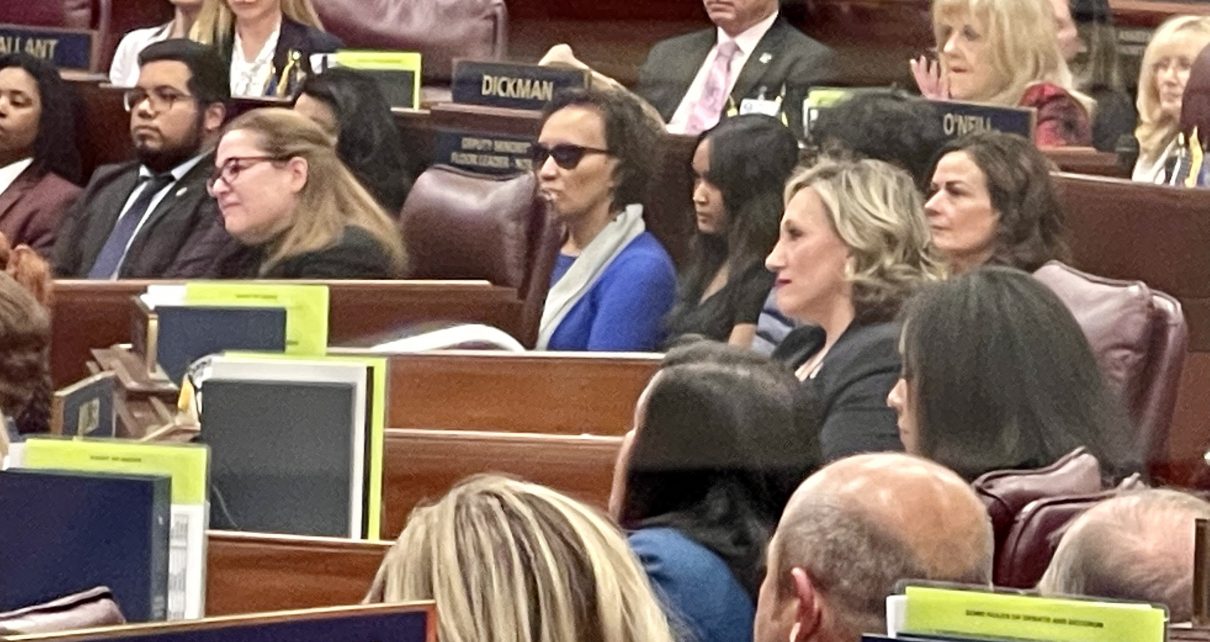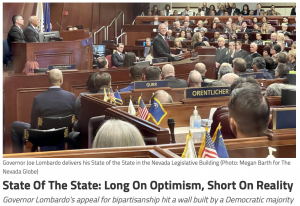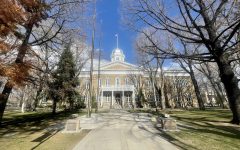
Senator Nicole Cannizzaro listens to State of the State (Photo: The Nevada Globe Editor for The Nevada Globe).
School Choice For Nevadans Isn’t A Reality With A Democratic Majority
If education advocates want to reform the education system in Nevada, they need to focus on local races in the 2024 election
By Megan Barth, June 7, 2023 4:07 pm
There were politically-connected winners by the close of last night’s legislative Special Session, and it wasn’t the legislative minority or the education advocates who believed that school choice and opportunity scholarship had a chance during this legislative session.
Education advocates, comprised of the CCEA, parents, kids, Republicans and moderate Democrats, believed that Governor Lombardo’s education priorities were worth a fight–a fight marked by popular legislation to reform a failed one-size-fits all public education system, gubernatorial vetoes, and a special session of the Nevada legislature.
According to polling, a majority of Nevadan’s support the Governor’s education proposals but, in political reality, the Democratic majority simply does not support any reform that provides choice and mobility as options for parents and students.
For background, after the State of the State, our headline read:

We reported:
As The Globe predicted, the speech was optimistic in tone, but fell short on reality as Governor Lombardo’s appeal for bipartisanship hit a wall built by a Democratic majority led by Senate Majority Leader Nicole Cannizzaro and Speaker-Elect Steve Yeager…
In his address, the Governor noted, “for the first time, parents will have an advocate inside government promoting the expansion of school choice in Nevada.”
The Governor had many advocates in government, but these advocates are members of a legislative minority who didn’t have the power to push his priorities over a partisan brick wall.
For example, instead of providing $35 million for public charter schools in the finalized budget presented in the Special Session as AB1, Senate Majority Leader Nicole Cannizzaro amended the bill to provide $25 million to a culinary school run by the Culinary Union– a union with a long history of political and financial ties to Nevada Democrats.
Following the governor’s State of the State address, Senate Majority leader Nicole Cannizzaro reiterated that the Democratic majority is working to better the lives of all Nevadans.
Yet, with this taxpayer donation to a culinary school, the majority leader showed no interest in bettering the lives of all Nevadans–just the lives of the politically-connected winners who will work to ensure that she and her Democratic colleagues remain in power.
WATCH: @HeidiGansert shreds Senate Dems for putting wasteful spending before solving problems.
"We've seen pork bills and there's been more bacon and lard tucked in those bills than you can find in a @FarmerJohnLA packing plant." #NVleg pic.twitter.com/6TWWM4as9j
— Nevada War Room – Better NV PAC (@BetterNevadaPAC) June 6, 2023
In Senate Minority Leader Heidi Gansert’s words, the Republican’s priorities of school choice “have been met with ‘disregard, disdain and dismissal.” Likewise, parents and the children who are trapped in a failing public school due to their zip code, have also been treated with disregard, disdain and dismissal by the Democratic majority.
Nevadans should note that the reason a special session was called was due to the fact that charter school funding was excluded by the Democrats in the Capital Investment budget (CIP). Their opposition to parity in the funding of pubic charters to public schools was reiterated last night by Republican Senators Ira Hansen (SD-14) and Heidi Gansert (SD-15) before they stood firm and voted against the CIP for a second time.
Context: Public School Teachers at Charter Schools got cheated out of a reasonable raise & should have been brought up to parity w other Public Teachers receiving a raise.
The entire time I have been in #nvleg we have been bouncing around the bottom of education in the country. pic.twitter.com/pfwYyTBIQI
— Ira Hansen (@Irahansen) June 7, 2023
The only Republican Senator who gave up the fight was Senator Scott Hammond (SD-18) who is leaving the Senate due to term limits.
After his vote, Hammond told the press, “This had to be done. We needed to end this. [Lombardo] called us into a special session to pass the CIP. I support him, and I support what’s in the CIP, and that’s what happened.”
A vote against the CIP wasn’t a vote against the Governor, it was a vote against a Democratic majority who treated the Governor, his fellow Republican colleagues, education advocates, parents, and struggling students with disdain.
Over in the Assembly, three Republicans broke with the Democratic Majority: Assm. Rich Delong (AD-26), Danielle Galant (AD-23), and Minority Leader PK O’Neill (AD-40).
Gallant told The Globe: “There are a lot of good things in AB1 which invests in our infrastructure and maintains our A+++ bond rating. It’s important that Nevadans know that Nevada is open for business and that the stagnation of the previous governor is in the past. Gov Lombardo is doing a phenomenal job and we need to continue to support his plan for the future of Nevada.”
If the Governor’s plan for the future of Nevada includes his legislative priorities that were dismissed by the Democratic majority, school choice supporters and Republicans need to create change by harnessing political power and focusing on local races in the 2024 election with effective and targeted messaging that solicits and elicits parental involvement.
In 2022, Republicans were not lifted to statewide power by a predicted red wave, but the midterm election marked a seismic shift to local school boards through the election of local, public school reform advocates across the country. This change wasn’t predicted by polls or due to legislation, this change occurred because parents disrupted the union-backed political power structure through the ballot box.
The Governor’s veto pen is running dry this session as he has, to date, vetoed 32 bills, bills which, in part, called for increased taxes, increased environmental regulations, and expanded gun control provisions.
In 2025, when Governor Lombardo presides over the next session of the Nevada legislature, local elections will determine whether or not the Democrats hold a supermajority in the Assembly and gain a supermajority in the Senate by flipping one seat.
Should a blue wave rise, the Governor will lose his power to veto any legislation and Nevadans will not have a chance to fight for school choice. Instead, they will be subjects of a political party that picks and chooses winners for their own political gain.
In other words, a majority of Nevadans will continue to be dismissed and treated with disdain by a political party who claims to be fighting for all Nevadans.
- Illegal Alien Identified As Wrong-Way Driver in Fatal Crash That Killed LVMPD Officer - December 23, 2024
- Senator Rosen Joins Letter Raising Concerns About Pete Hegseth’s Nomination - December 20, 2024
- NV SOS Launches Four Investigations Into 2024 Election Violations - December 20, 2024





To the people adverse to school choice. You are misguided. You may find publications and studies that are activism backed to promote your “theory”, that school choice is racist.
Back in the day there was affirmative action. I benefited from it in the 1980’s. I got to go to schools outside my zip code. I got to go schools that got me out of the environment I would have been subjected too, while simply trying to learn. Still had to deal with a bit of it and the buying. The chocolate bus.
If you are against school choice then you unfortunately are being very regressive back to the 1960’s, 70’s and 80’s.
Here is an article:
“ According to nearly every empirical study on the topic, school vouchers lead to more ethnic and racial integration in schools, so there is virtually no evidence to support that vouchers, in practice, result in more racial or ethnic stratification.
Moreover, school choice breaks down the socioeconomic barriers to entry that have historically prevented many American students from accessing schools that work best for them.
A new international study found that Latin American countries with traditional district-based education systems have experienced increased social stratification; meanwhile, Chile’s free school choice system—a universal voucher system—has not significantly increased the degree of segregation in schools. In fact, Chile’s voucher system has mitigated the segregation trends seen in other countries with similar histories and cultures.
To be frank, rich people have always been able to practice educational choice: They either pay out of pocket for private schools, or they pay a premium to buy houses in neighborhoods with “good public schools.”
So, what happens to everyone else?
We know for a fact that our current ZIP Code-based public education system has kept too many low-income students and students of color out of quality schools.
And studies have shown today’s system also continues to contribute to the exacerbation of socioeconomic segregation in neighborhoods and, thus, public schools. Educational choice, on the other hand, is designed to help all children, regardless of their income or neighborhood.
Even in states where school choice programs are open to families of all incomes, the programs primarily help low- and middle-income families. That said, we should never presume to know every family’s unique circumstances or hardships, and neither should our country’s education policies. In all its forms, school choice gives low-income families more opportunities to access schooling options they might never have been able to access before—options that were formerly only available to the wealthy.
Choice and access level the playing field for everyone. And after all, wasn’t our great nation founded on the principles of liberty and equality—not just opportunity for those who can afford it?” https://www.edchoice.org/school-choice/faqs/does-school-choice-make-school-segregation-better-or-worse/
Education is a right. The best education possible is a right and should be lauded in all efforts toward equality. Our tax dollars need to squarely rest with providing the best opportunities for youth, our future leaders. NOT with unions, activists and individuals who’s opinion will be jaded as civil servants, ie. public school teachers. Only the best for our future generations. Not your pension folks. Stop being selfish.
Good job Megan.